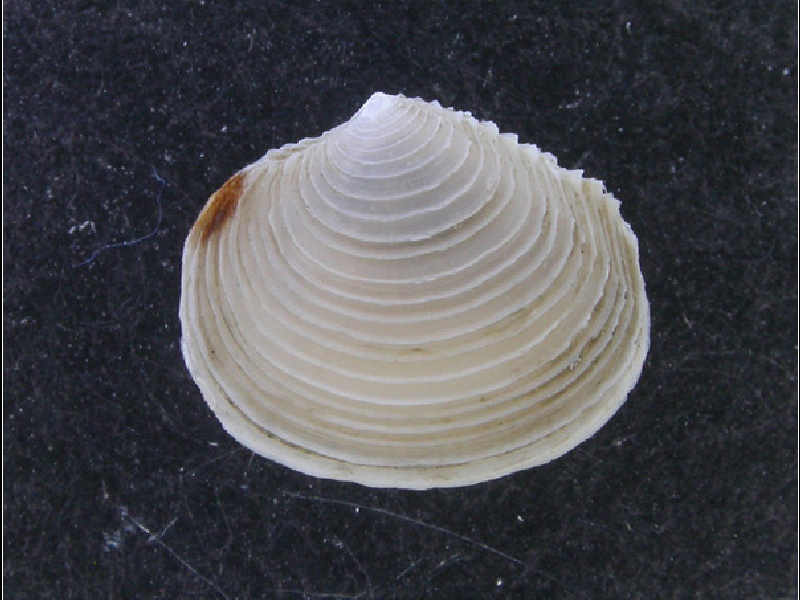A bivalve mollusc (Myrtea spinifera)
Distribution data supplied by the Ocean Biodiversity Information System (OBIS). To interrogate UK data visit the NBN Atlas.Map Help
| Researched by | Kelsey Lloyd | Refereed by | Admin |
| Authority | (Montagu, 1803) | ||
| Other common names | - | Synonyms | - |
Summary
Description
A bivalve with a thick, broadly oval shell up to 2.5 cm in length. Both valves are similar in size and shape and are almost symmetrical, with the beak positioned in front of the mid-line of the shell pointing inwards. The inner surface is white and the outer surface can be white or cream. The outer surface can be covered with a pale beige layer (periostracum). The outside of the shell bears patterns of concentric ridges, with fine concentric lines in between them. The anterior and posterior edges of the shell may bear rounded projections (tubercles).
Recorded distribution in Britain and Ireland
Myrtea spinifera is recorded most commonly along the north-eastern coasts of Scotland, as far as the Shetland Islands, and along the western coasts from southwest England, and the east coast of Ireland to the west coast of Scotland. It is less common in the southern North Sea and along the east coast of England.
Global distribution
Distributed from Norwegian Sea, south to Iberian Peninsula into Mediterranean, and along the Atlantic coast of Morocco to Madeira and the Azores.
Habitat
Myrtea spinifera inhabits soft mud, muddy or silty sand, or muddy gravel at the bottom of the circalittoral zone to about 100 m in depth.
Depth range
Offshore to about 100 mIdentifying features
- Sub-oval in outline with posterior margin squared off.
- Shell up to 2.5 cm in length and is longer than it is high.
- Shell bears patterns of fine concentric ridges with concentric lines in between them.
- Both valves are similar in size and shape (equivalve).
- The beak is in front of the mid-line, directing inwards (inequilateral).
- Inner surface of the shell is white and outer surface of the shell is white or cream.
- Right valve has a single cardinal tooth and single anterior and posterior lateral teeth.
- Left valve has two cardinal teeth and single anterior and posterior lateral teeth.
- The periostracum, if present, is pale beige.
Additional information
-none-Listed by
- none -
Bibliography
Cresti, M. & Forli, M., 2018. On some Pliocene Lucinidae J.Fleming, 1828 (Bivalvia) from Orciano Pisano (Pisa, Italy) with the proposal to establish a new species: Alucinoma (?) persquamulosa (Sacco, 1901). Biodiversity Journal, 9 (4), 411-424. DOI https://doi.org/10.31396/Biodiv.Jour.2018.9.4.411.424
De Kluijver, M.J., Ingalsuo, S.S. & de Bruyne, R.H., 2021. Mollusca of the North Sea. Marine Species Information Portal. Leiden, The Netherlands: ETI Bioinformatics. Available from: http://species-identification.org/species.php?species_group=mollusca&menuentry=inleiding
Hayward, P.J. & Ryland, J.S. (ed.) 1995b. Handbook of the marine fauna of North-West Europe. Oxford: Oxford University Press.
Hayward, P.J. & Ryland, J.S. (ed.) 2017. Handbook of the marine fauna of North-West Europe. Oxford: Oxford University Press.
Oliver, P.G., Holmes, A.M., Killeen, I.J. & Turner, J.A., 2016. Marine Bivalve Shells of the British Isles. Amgueddfa Cymru - National Museum Wales. Available from: http://naturalhistory.museumwales.ac.uk/britishbivalves [Cited: 3 July 2018].
Tebble, N., 1976. British Bivalve Seashells. A Handbook for Identification, 2nd ed. Edinburgh: British Museum (Natural History), Her Majesty's Stationary Office.
Datasets
Conchological Society of Great Britain & Ireland, 2023. Mollusc (marine) records for Great Britain and Ireland. Occurrence dataset: https://doi.org/10.15468/aurwcz accessed via GBIF.org on 2024-09-27.
NBN (National Biodiversity Network) Atlas. Available from: https://www.nbnatlas.org.
OBIS (Ocean Biodiversity Information System), 2025. Global map of species distribution using gridded data. Available from: Ocean Biogeographic Information System. www.iobis.org. Accessed: 2025-07-01
Citation
This review can be cited as:
Last Updated: 22/09/2021
- Bivalve
- Mollusc



